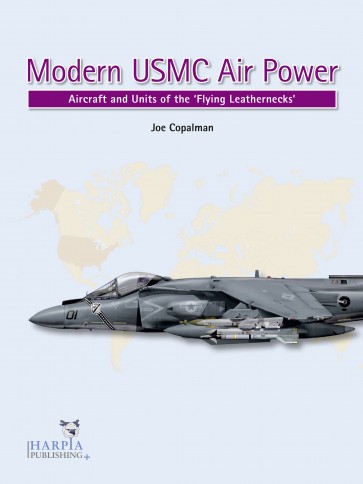
Modern USMC Air Power. by Joe Copalman. Harpia Publishing, 2020. Distributed by Casemate Publishers – www.casematepublishers.co.uk. ISBN 978-1-950394-02-9.
Reviewed by David Hobbs
This is the first book by Joe Copalman, an American aviation enthusiast who has previously written feature articles for magazines and journals. He is an acknowledged expert on the US Marine Corps and its aircraft, a fact that is immediately apparent from the quality and authority with which he has covered his subject. This 253 page book is well illustrated with excellent colour photographs, maps and diagrams.
The text is divided into fifteen chapters supported by further pages of abbreviations, colour representation of flying unit badges, a bibliography and an index. They take the reader in a logical sequence from a brief history of aviation within the Corps, through a description of its organisation and structure in 2020 to the way in which pilots and flight officers are trained.
The one minor weakness is the lack of a description of how crew chiefs, loadmasters and helicopter aircrewmen, all mentioned in the text, are selected and trained. The remaining chapters are devoted to specific roles and the aircraft types that fulfil them, starting with heavy lift helicopters. Sequentially the following chapters cover light attack helicopters, the evolution of Marine medium lift capability culminating in the MV-22B Osprey, electronic warfare, fighter attack, aerial refuelling/transport, operational support, unmanned air vehicle, executive flights and test/evaluation specialisations. Each one starts with a brief history of the role and then moves into succinct but detailed descriptions of the current aircraft, their weapons and systems.
There are a number of well-chosen quotations from interviews the author had with Marine aviators as he researched this book which add value to the text. Brief summaries of aircraft and equipment used since 2000 are included so that the reader can understand the enormous contemporary advances in capability.
Operations carried out over the past twenty years are also described to give an idea of how current tactics are evolving as the Corps moves fully into the digital age. The last chapter looks at the immediate future although, wisely, the author goes no further than the USMC force design initiative of March 2020.
Copalman wrote this book in the year between the summers of 2019 and 2020 and admits that during that short span of time it sometimes seemed as if the Corps published new policies or acquisition policies every week. His book is as up to date as possible today, however, and will be an important source of information for several years to come. Hopefully its publisher will be able to produce updated editions at appropriate intervals.
The USMC operates aircraft within air-ground task forces across the globe, both embarked in LHAs, LHDs and other amphibious ships as well as both permanent and expeditionary short-term bases ashore and is able to react quickly to any situation across the world, frequently alongside the amphibious forces of close allies such as Australia, the UK and Japan. One of this book’s strengths is that it contains a quick but reliable reference for naval professionals who are likely to find themselves working with an American amphibious task force.
The USMC prides itself on being ‘the first to fight’, buying time for armies and air forces to mobilise; its units are, therefore, likely to be the first American forces in action during the opening days of any future conflict. What impressed me most about Copalman’s work is his complete understanding of the Corps’ ethos, ‘every Marine a rifleman first and foremost’, within which the whole purpose of Marine Air is to support riflemen on the ground. That purpose shows in every aspect of the Corps’ aircraft roles, equipment, pilot training and tasking.
In my experience of joint and coalition operations, air forces such as the RAAF, RAF and USAF tend to follow a more dogmatic approach, telling their sister-services what their aircraft cannot do for various reasons and why their own pre-conceived plans have to be given priority. The USMC rightly puts the men on the ground first and sees aircraft as tools to help them fight; many air staff officers in other countries could learn from this approach. There are a number of references to operations alongside British and Australian forces in the text and a photograph of a USMC F-35 operating from HMS Queen Elizabeth in 2020 on page 181.
I found the description of digital interoperability as a means of enhancing en-route situational awareness between assault forces airborne in MV-22Bs, the command and forces in action on the ground to be of great interest.
The description of sensor-shooter integration between the F-35B, other aircraft, missile-equipped warships and the direction of high-mobility artillery rocket systems was also fascinating and an excellent, if short, guide to some of the things that this remarkable aircraft and its systems can achieve. It is so much more than just the fighter many people assume it to be. This is a book that must cause readers to wonder how much more could be achieved in operations from the two RAN LHDs in the years ahead.
Apart from its obvious interest to naval professionals this book must also appeal to anyone with an interest in current military aviation technology and tactics. Air warfare has evolved significantly over the past decade and continues to do so. I recommend it thoroughly and unreservedly.



